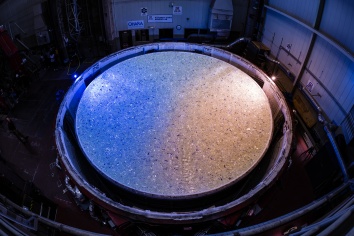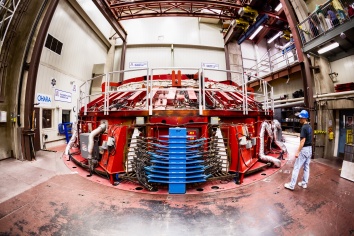UT Austin and Partners Cast Fifth Massive Mirror for Giant Magellan Telescope
3 November 2017
TUCSON, Ariz. — Today, The University of Texas at Austin and its partners in the Giant Magellan Telescope Organization (GMTO) are beginning to cast the fifth of seven mirrors that will form the heart of the Giant Magellan Telescope (GMT). The mirror is being cast at The University of Arizona’s Richard F. Caris Mirror Laboratory, a facility known for creating the world’s largest mirrors for astronomy. The 25-meter diameter GMT will be located in the Chilean Andes and will study planets around other stars and to look back to the time when the first galaxies formed.
Dr. Taft Armandroff, Director of UT Austin’s McDonald Observatory and Vice-Chair of the GMTO Board, will travel to Tucson with a group of Texas donors to attend the casting ceremony at the mirror lab.
“Creating the largest telescope in history is a monumental endeavor and will enable breakthrough discoveries,” Armandroff said. “With this milestone of casting the fifth mirror, and with the scientific, technical, leadership, and financial prowess of the 11 institutions that form the GMTO partnership, we continue on the path to the completion of this great observatory.”
The process of “casting” the giant mirror involves melting nearly 20 tons of glass in a spinning furnace. Once cooled, the glass disk will be polished to its final shape using state-of-the-art technology.
The GMT will combine the light from seven of these 8.4-meter mirrors to create a telescope with an effective aperture 24.5 meters in diameter (80 feet). With its unique design, the GMT will produce images that are 10 times sharper than those from Hubble Space Telescope in the infrared region of the spectrum.
Each of GMT’s light-weighted mirrors is a marvel of engineering. The mirrors begin as pristine blocks of custom-manufactured, low-expansion glass from the Ohara Corporation of Japan. Precisely 17,481 kg of these glass blocks have been placed by hand into a custom-built furnace pre-loaded with a hexagonal mold. At the peak of the lengthy casting process, in which the giant furnace spins at up to five revolutions per minute, the glass is heated to 1165°C (2129°F) for about four hours until it liquefies and flows into the mold. The casting process continues as the glass is carefully cooled for three months while the furnace spins at a slower rate. The glass then undergoes an extended period of shaping and polishing. The result of this high-precision process is a mirror that is polished to an accuracy of one twentieth of a wavelength of light, or less than one thousandth of the width of a human hair.
With its casting this weekend, the fifth GMT mirror joins three additional GMT mirrors at various stages of production in the mirror lab. Polishing of mirror 2’s front surface is well underway; coarse grinding will begin on the front of the third mirror shortly and mirror number 4, the central mirror, will soon be ready for coarse grinding following mirror 3. The first GMT mirror was completed several years ago and was moved to a storage location in Tucson this September, awaiting the next stage of its journey to Chile. The glass for mirror 6 has been delivered to Tucson and mirror seven’s glass is on order from the Ohara factory in Japan.
In time, the giant mirrors will be transported to GMT’s future home in the Chilean Andes at the Carnegie Institution for Science’s Las Campanas Observatory. This site is one of the best astronomical sites on the planet with its clear, dark skies and stable airflow producing exceptionally sharp images. GMTO has broken ground in Chile and has developed the infrastructure on the site needed to support construction activities.
— END —
Note to editors: Additional images and videos are available: https://arizona.app.box.com/v/gmtohighfire
Media Contact
Rebecca Johnson, Communications Mgr.
McDonald Observatory
The University of Texas at Austin
512-475-6763
Science Contact
Dr. Taft Armandroff
Vice-Chair, GMTO Board of Directors
Director, McDonald Observatory
The University of Texas at Austin
512-471-3300
About the Giant Magellan Telescope Organization
The Giant Magellan Telescope Organization (GMTO) manages the GMT project on behalf of its US and international partners: Astronomy Australia Ltd., The Australian National University, Carnegie Institution for Science, Fundação de Amparo à Pesquisa do Estado de São Paulo, Harvard University, Korea Astronomy and Space Science Institute, Smithsonian Institution, Texas A&M University, The University of Texas at Austin, University of Arizona, and University of Chicago.









